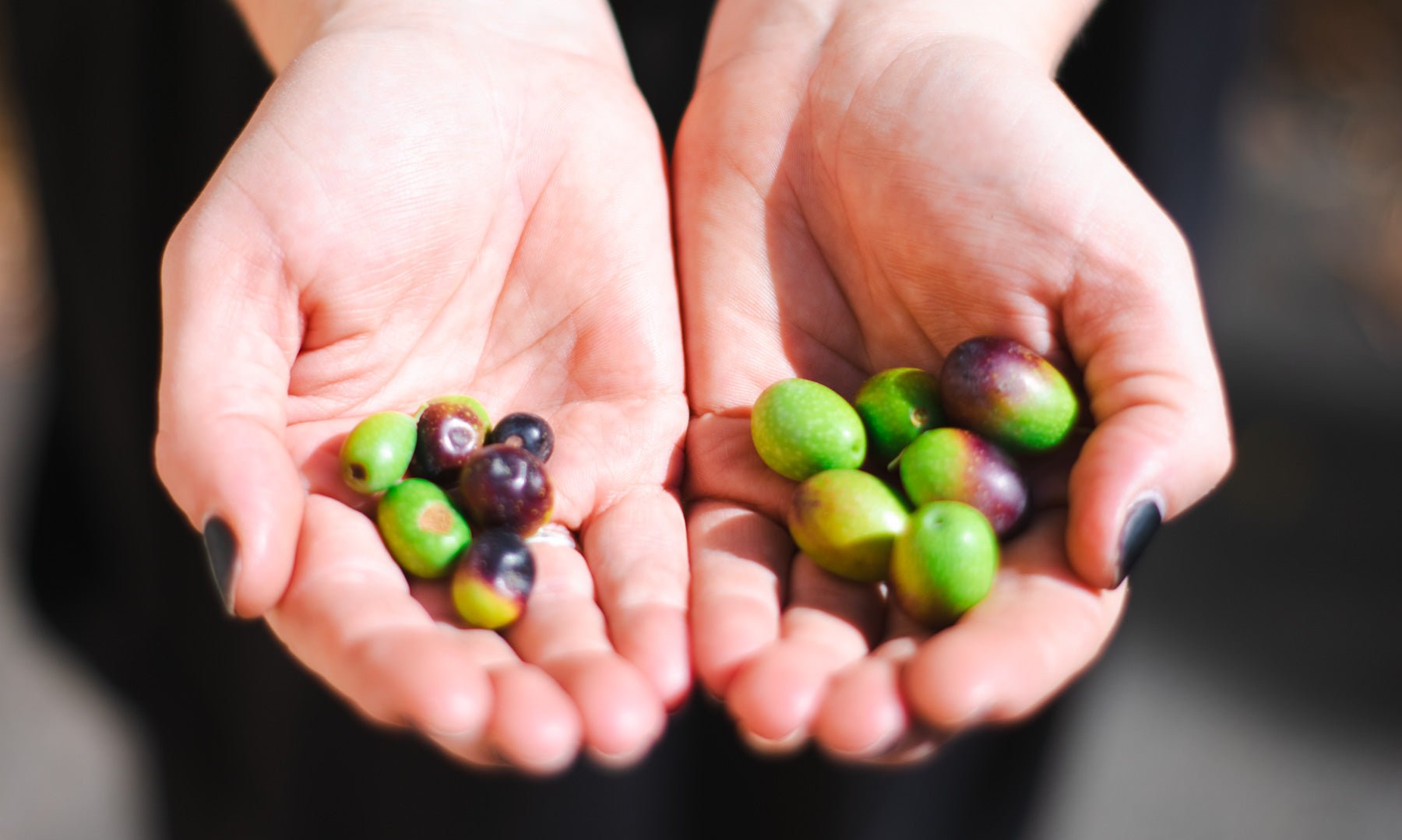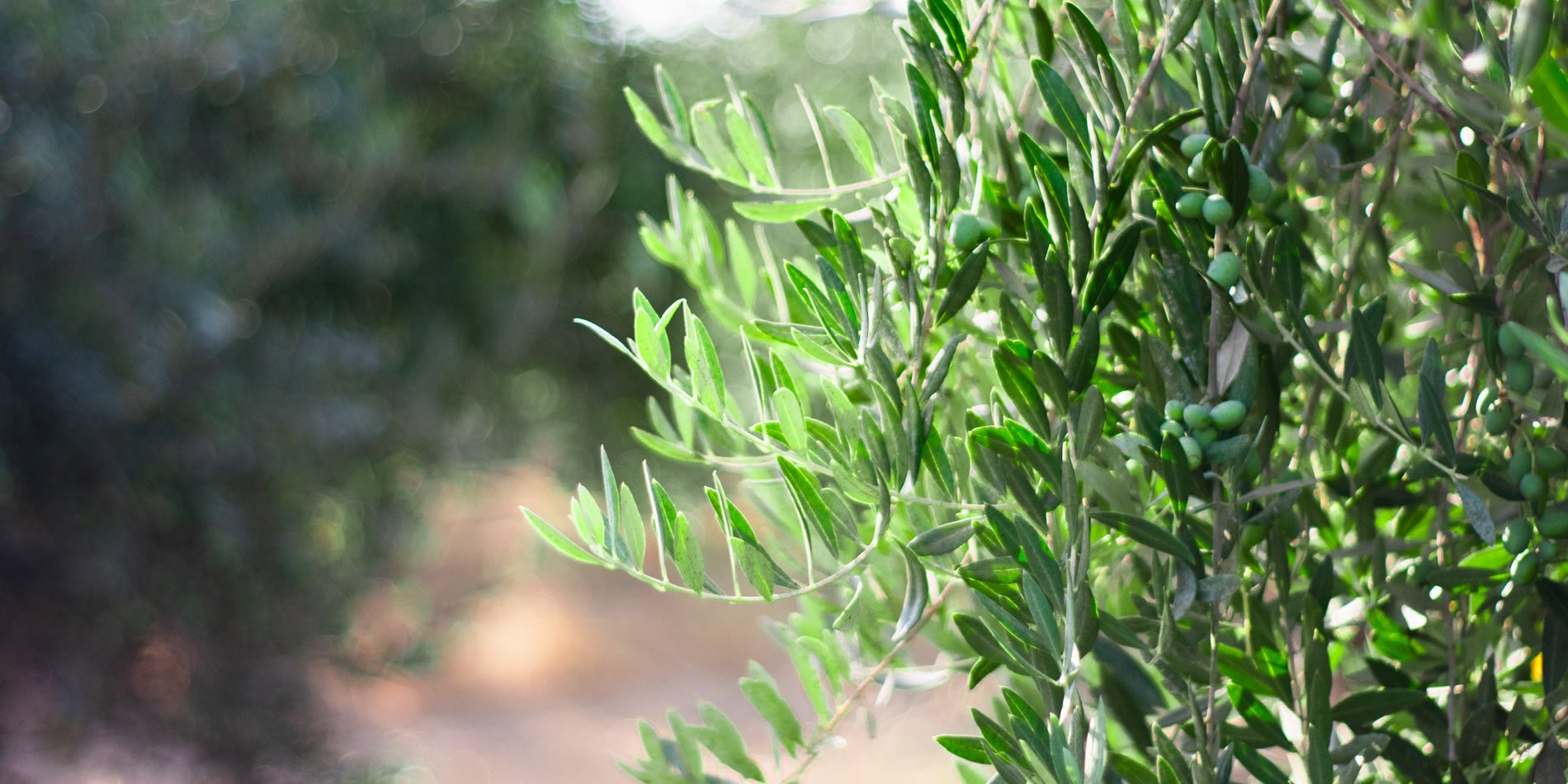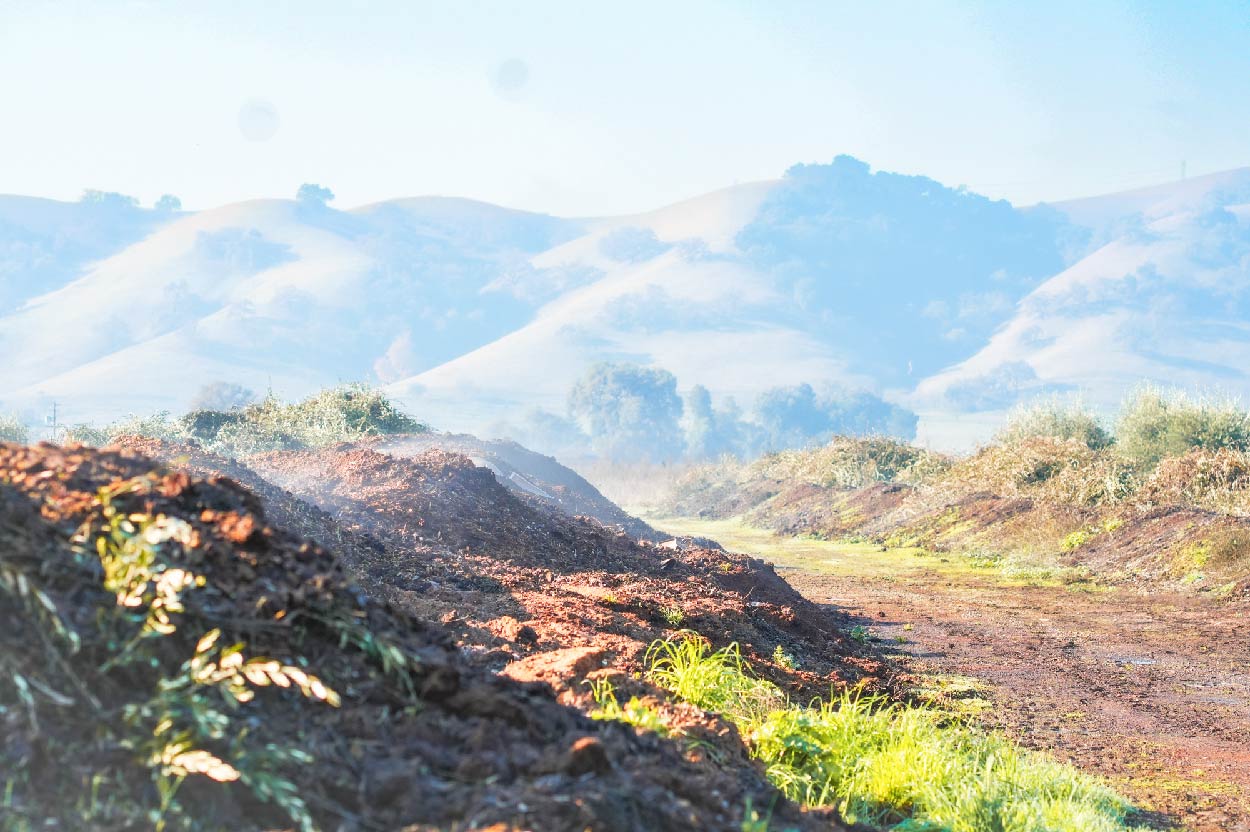All About Polyphenol Rich Olive Oil
Polyphenol rich olive oil isn’t just a health trend, it’s the result of real choices made on the farm, in the mill, and at harvest. This article explores what polyphenols are, how they function in olive oil, and how you can recognize and use oils that are rich in them. From managing drought stress to dialing in harvest timing, milling, and storage, we walk through the full process of producing a polyphenol rich olive oil that’s actually good to cook with. We also break down what pungency, bitterness, and astringency tell you about an oil, and how to spot the ones that deserve a place in your kitchen.

"An oil can be 'good for you' in theory, but the polyphenol concentration of an oil doesn’t matter if you don’t actually use it!"
What Are Polyphenols
Polyphenols are part of a group of compounds called secondary plant metabolites. If primary metabolites are things like carbohydrates, fats, proteins - basically the stuff a plant needs just to function - then secondary metabolites are the cream on top. They’re not essential for survival in a basic sense, but they play a huge role in how a plant interacts with its environment. Think of things like the compounds that give peppers their heat, or the aromas that attract pollinators or signal that a fruit is ripe. These compounds can act as signals, defenses, or protective agents, and polyphenols are a big part of that.
In olives, polyphenols show up in relatively large quantities, and they stick around in the oil we press from them. There are a number of different polyphenols found in olive oil, each with its own structure and job, from protecting the olive seed from oxidation, to discouraging animals from eating the fruit before it’s ready.
We’re especially interested in polyphenols for a few reasons. First, they help prevent oxidation in the oil, which means they protect it from going rancid. That’s not just about shelf life, it’s about preserving flavor and preventing the formation of oxidized fats, which aren’t great for your health. We’ll dig into that more in another post.
Second, polyphenols contribute significantly to the flavor of the oil. They’re what give high quality extra virgin olive oil its signature peppery bite, its grassy edge, that sense of brightness and complexity. The more diverse and present these compounds are, the more lively and expressive the oil tends to be.
Of course, there’s also the health angle. We’re always thinking about flavor first, but polyphenols also support the cardiovascular system, brain health, skin integrity, and immune function. You’ll see headlines tying them to cancer prevention or anti aging effects, and while some of that gets hyped, the underlying science points to real, broad spectrum benefits.
How Polyphenols Appear in Olive Oil
Polyphenols occur naturally in every part of the olive tree, and are especially concentrated in the leaves and flesh of the fruit. But the oil itself, (how it exists inside the olive on the tree), isn’t particularly high in polyphenols, because the oil is stored in microscopic droplets within the cells as an energy reserve. If we carefully manage both the way we grow the olives and the way we extract the oil, we will be rewarded with the holy grail of EVOO - Polyphenol Rich Olive Oil.
One common way to boost polyphenol levels in the fruit is to induce drought stress during the growing season, which forces the tree into survival mode and triggers a spike in polyphenol production. Oils made from these trees can be incredibly high in polyphenols, but they’re also often extremely bitter. They’re interesting to taste in an industry tasting panel, but they’re not the kind of oils most people reach for when they cook. I buy a few each year out of curiosity, but honestly, they tend to sit around until I toss them a year or two later. An oil can be “good for you” in theory, but the polyphenol concentration of an oil doesn’t matter if you don’t actually use it!
Our approach is different. Instead of pushing the tree into fight or flight mode, we focus on growing the most robust, metabolically healthy tree we can. That starts with the soil - we avoid herbicides and heavy tillage, keep the soil covered year round to insulate it from extreme weather, and integrate livestock into the system. (In fact, there’s good evidence that sheep browsing on olive leaves can actually stimulate beneficial plant responses and improve markers of tree health).
Additionally, we do use irrigation and fertilizer, but the goal isn’t to push yield, it’s to support the plant’s ability to thrive. We water lightly and often to keep the soil biology active, and our mineral supplementation is focused on full spectrum mineral balance to ensure healthy growth and moderate vigor - we don’t just dump NPK to fatten up our trees.
Next comes harvest. There’s a trade off between polyphenol levels and fruit maturity. Early harvest olives, especially when picked green, are high in polyphenols but produce low yields and can be intensely bitter, (especially when coming from trees grown in poor soil or stressed conditions). Later harvest olives give you more oil and a rounder flavor, but the polyphenols drop as the fruit ripens and those compounds break down or transform. Our sweet spot is somewhere in the middle - we harvest when about a third of the fruit has just started to turn color. The skins have developed some purple pigmentation, but the flesh is still green. Generally, our harvest brings in fruit with a maturity index between 1.5 and 2, out of 10, so we still get a punchy, grassy oil, but with a little softness around the edges.
Once we harvest, time is critical. Fruit that sits around bruises easily, and that bruising sets off enzymatic reactions that break down polyphenols and heat up the fruit mass. That heat can accelerate fermentation and lead to off flavors. We mill everything on site, usually within 45 minutes and always within four hours. That quick turnaround keeps oxidation and heat damage to a minimum.
Even milling is a balancing act. The oil doesn’t actually contain a lot of polyphenols before harvest, so we have to extract the polyphenols from the olive paste while we separate the oil. That takes careful crushing, controlled heat, and just the right amount of time spent in the malaxer - where the paste is slowly kneaded to release the oil and extract the polyphenols from the fruit into the oil.
Finally, once the oil is separated, we “sparge” it with nitrogen (bubble inert gas through the oil to remove oxygen), then pump it straight into stainless steel tanks where it will be further purged with nitrogen to ensure complete oxygen exclusion. The tanks are stored in a well insulated, climate controlled room to keep everything stable until bottling .
How to Identify Polyphenol Rich Olive Oil
There are a few ways to identify polyphenol rich olive oil. The most reliable is to buy directly from a farm or mill that posts their chemical parameters, and ideally a direct link to a third party lab report.That’s the best way to know for sure what the polyphenol level is.
Beyond that, there are a few key indicators that can help you assess things indirectly. First is freshness. While proper storage can preserve quality and slow the decline of polyphenols, nothing really beats fresh oil. And in many cases, olive oil that’s been stored, transported, bottled, and shelved may have already lost much of its punch, especially if it’s been exposed to light or heat.
A “best by” date is helpful, but it’s subjective and can be manipulated. What you really want is a harvest date which gives you a concrete reference point. Generally speaking, olive oil is still good for about two years, but it’s at its best within the first year. And if you can find an olio nuovo duringharvest, it can be a life changing experience - bright, expressive, and densely packed with polyphenols.
Another label detail to watch is origin. The more specific the better. A lot of mass market olive oils are blended from bulk lots, sometimes from multiple countries. While that’s not inherently bad, it does make transparency around harvest dates and polyphenol content more difficult, and in practice often means the oil is likely inferior.
Now, let’s talk flavor. Polyphenols add complexity and brightness to oil, but they also contribute bitterness, pungency, and astringency - three sensations that are often misunderstood or lumped together.
Here’s the three main elements of robust olive oil and how to tell them apart:
- Pungency is a physical sensation, think raw garlic or fresh chiles. It builds and lingers, sometimes making you cough.
Bitterness is more like mustard/dandelion greens, dark chocolate, or oversteeped tea. It hits quickly and fades fast.
Astringency is a drying sensation. The classic example is a raw artichoke. In lab terms, the sensory standard is alum, which is the active ingredient in most deodorants. If you’ve ever (accidentally) tasted that, you know what I mean.

It takes practice to sort these sensations out, but even without formal training, there are clues. If the oil is buttery, fruity, soft, and round, it might be delicious, but it’s probably not a high polyphenol oil. If it makes you cough a little, grabs your throat, or has a bite that wakes you up, that’s a good sign that this is a good, fresh oil - full of polyphenols. These are oils to use, not hoard. They won’t last forever, so enjoy them while they’re fresh.
Back to lab tests for a second. They can be a bit confusing, especially since different labs use different reference standards. Some report in milligrams per kilogram using hydroxytyrosol, others use caffeic acid equivalents. The underlying data may be the same, but the numbers can vary by 20–30%, like comparing miles to kilometers. So comparing oils tested by different labs can be a moot point if the results are reasonably close.
That said, here’s a general ballpark:
- 100 to 200 ppm = typical commercial olive oil
300 to 400 ppm = high quality, well handled oil.
500+ ppm = rare, usually from stressed trees; technically impressive, but often too bitter to enjoy in the kitchen
And that’s the key: an oil can be packed with polyphenols but not be very enjoyable to use and cook with. It’s a balancing act between health benefits, flavor, and how you actually cook and eat.
Conclusion
At Frantoio Grove, we do a lot of work to ensure that we have a robust, polyphenol rich olive oil that’s balanced and approachable—assertive enough to serve as a nice finishing oil, but not so strong that it becomes difficult to use or out of place in dishes. It’s important to remember that polyphenols can be tremendously impactful to our health, but many plants contain a wide array of secondary metabolites that also support human health.
We absolutely encourage the consumption of high-quality, polyphenol rich olive oil, but it’s just one part of the picture. Perhaps the single most important advice I could give is to focus on creating a rainbow on every plate. Many of the pigments found in plants—from the deep red of a cabernet to the bright purple of fresh cabbage and the rich greens of leafy vegetables—aren’t just beautiful, they’re beneficial compounds in their own right. These compounds provide neuroprotective benefits, anticancer effects, improvements to cardiovascular health, and more.
And maybe, more than finding the most polyphenol-rich olive oil, the more important thing is to find practices you can engage with meaningfully every day. Something you’ll actually reach for and use. Because the best olive oil in the world doesn’t do you much good if it just sits on a shelf.






